线程池
自定义线程池
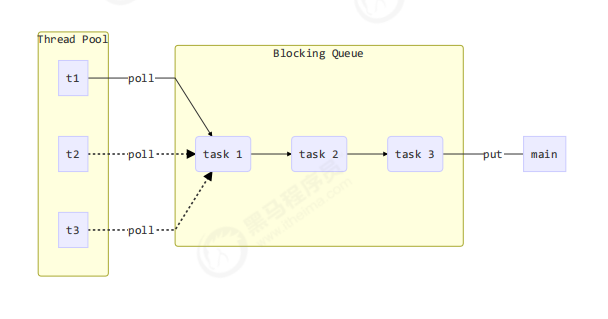
步骤1:自定义拒绝策略接口
@FunctionalInterface // 拒绝策略interface RejectPolicy<T> {void reject(BlockingQueue<T> queue, T task);}
步骤2:自定义任务队列
class BlockingQueue<T> {// 1. 任务队列private Deque<T> queue = new ArrayDeque<>();// 2. 锁private ReentrantLock lock = new ReentrantLock();// 3. 生产者条件变量private Condition fullWaitSet = lock.newCondition();// 4. 消费者条件变量private Condition emptyWaitSet = lock.newCondition();// 5. 容量private int capcity;public BlockingQueue(int capcity) {this.capcity = capcity;}// 带超时阻塞获取public T poll(long timeout, TimeUnit unit) {lock.lock();try {// 将 timeout 统一转换为 纳秒long nanos = unit.toNanos(timeout);while (queue.isEmpty()) {try {// 返回值是剩余时间if (nanos <= 0) {return null;}nanos = emptyWaitSet.awaitNanos(nanos);} catch (InterruptedException e) {e.printStackTrace();}}T t = queue.removeFirst();fullWaitSet.signal();return t;} finally {lock.unlock();}}// 阻塞获取public T take() {lock.lock();try {while (queue.isEmpty()) {try {emptyWaitSet.await();} catch (InterruptedException e) {e.printStackTrace();}}T t = queue.removeFirst();fullWaitSet.signal();return t;} finally {lock.unlock();}}// 阻塞添加public void put(T task) {lock.lock();try {while (queue.size() == capcity) {try {log.debug("等待加入任务队列 {} ...", task);fullWaitSet.await();} catch (InterruptedException e) {e.printStackTrace();}}log.debug("加入任务队列 {}", task);queue.addLast(task);emptyWaitSet.signal();} finally {lock.unlock();}}// 带超时时间阻塞添加public boolean offer(T task, long timeout, TimeUnit timeUnit) {lock.lock();try {long nanos = timeUnit.toNanos(timeout);while (queue.size() == capcity) {try {if(nanos <= 0) {return false;}log.debug("等待加入任务队列 {} ...", task);nanos = fullWaitSet.awaitNanos(nanos);} catch (InterruptedException e) {e.printStackTrace();}}log.debug("加入任务队列 {}", task);queue.addLast(task);emptyWaitSet.signal();return true;} finally {lock.unlock();}}public int size() {lock.lock();try {return queue.size();} finally {lock.unlock();}}public void tryPut(RejectPolicy<T> rejectPolicy, T task) {lock.lock();try {// 判断队列是否满if(queue.size() == capcity) {rejectPolicy.reject(this, task);} else { // 有空闲log.debug("加入任务队列 {}", task);queue.addLast(task);emptyWaitSet.signal();}} finally {lock.unlock();}}}
步骤3:自定义线程池
class ThreadPool {// 任务队列private BlockingQueue<Runnable> taskQueue;// 线程集合private HashSet<Worker> workers = new HashSet<>();// 核心线程数private int coreSize;// 获取任务时的超时时间private long timeout;private TimeUnit timeUnit;private RejectPolicy<Runnable> rejectPolicy;// 执行任务public void execute(Runnable task) {// 当任务数没有超过 coreSize 时,直接交给 worker 对象执行// 如果任务数超过 coreSize 时,加入任务队列暂存synchronized (workers) {if (workers.size() < coreSize) {Worker worker = new Worker(task);log.debug("新增 worker{}, {}", worker, task);workers.add(worker);worker.start();} else {// taskQueue.put(task);// 1) 死等// 2) 带超时等待// 3) 让调用者放弃任务执行// 4) 让调用者抛出异常// 5) 让调用者自己执行任务taskQueue.tryPut(rejectPolicy, task);}}}public ThreadPool(int coreSize, long timeout, TimeUnit timeUnit, int queueCapcity,RejectPolicy<Runnable> rejectPolicy) {this.coreSize = coreSize;this.timeout = timeout;this.timeUnit = timeUnit;this.taskQueue = new BlockingQueue<>(queueCapcity);this.rejectPolicy = rejectPolicy;}class Worker extends Thread {private Runnable task;public Worker(Runnable task) {this.task = task;}@Overridepublic void run() {// 执行任务// 1) 当 task 不为空,执行任务// 2) 当 task 执行完毕,再接着从任务队列获取任务并执行// while(task != null || (task = taskQueue.take()) != null) {while (task != null || (task = taskQueue.poll(timeout, timeUnit)) != null) {try {log.debug("正在执行...{}", task);task.run();} catch (Exception e) {e.printStackTrace();} finally {task = null;}}synchronized (workers) {log.debug("worker 被移除{}", this);workers.remove(this);}}}}
步骤四:测试
public static void main(String[] args) {ThreadPool threadPool = new ThreadPool(1,1000, TimeUnit.MILLISECONDS, 1, (queue, task)->{// 1. 死等// queue.put(task);// 2) 带超时等待// queue.offer(task, 1500, TimeUnit.MILLISECONDS);// 3) 让调用者放弃任务执行// log.debug("放弃{}", task);// 4) 让调用者抛出异常// throw new RuntimeException("任务执行失败 " + task);// 5) 让调用者自己执行任务task.run();});for (int i = 0; i < 4; i++) {int j = i;threadPool.execute(() -> {try {Thread.sleep(1000L);} catch (InterruptedException e) {e.printStackTrace();}log.debug("{}", j);});}}
自己实现的线程池
@Slf4j(topic = "c.PoolTest1")public class PoolTest1 {public static void main(String[] args) {Pool pool = new Pool(2, 1000, TimeUnit.MILLISECONDS, 1, (queue, task) -> {// 死等// queue.push(task);// 带超时等待// queue.offer(task, 2000,TimeUnit.MILLISECONDS);// 让调用者放弃任务执行// log.info("啥都不写,就是放弃{}!!!", task);// 让调用者抛出异常// throw new RuntimeException("抛出异常,后面的都不能运行");// 让调用者自己操作task.run();});for (int i = 0; i < 4; i++) {int j = i;pool.execute(() -> {try {Thread.sleep(1000);} catch (InterruptedException e) {e.printStackTrace();}log.info("{}", j);});}}}@Slf4j(topic = "c.Pool")class Pool {// 任务队列private BlockingQueues<Runnable> taskQueue;// 线程集合private HashSet<Work> workers = new HashSet<>();// 核心线程数private int coreSize;// 获取任务的超时时间private long timeout;// 队列的容量private TimeUnit timeUnit;// 拒绝策略的接口private RejectPolicy<Runnable> rejectPolicy;public Pool(int coreSize, long timeout, TimeUnit timeUnit, int queueCapicity, RejectPolicy<Runnable> rejectPolicy) {this.taskQueue = new BlockingQueues<>(queueCapicity);this.coreSize = coreSize;this.timeout = timeout;this.timeUnit = timeUnit;this.rejectPolicy = rejectPolicy;}// 执行任务public void execute(Runnable task) {// 锁住workerssynchronized (workers) {if (workers.size() < coreSize) {// 创建新的工作线程Work work = new Work(task);log.info("新增worker:{}", work);// 放入工作线程集合workers.add(work);work.start();} else {// 如果工作线程不够用,放入阻塞队列中// 死等// taskQueue.push(task);taskQueue.tryPut(rejectPolicy, task);}}}class Work extends Thread {// 任务private Runnable task;public Work(Runnable task) {this.task = task;}@Overridepublic void run() {// 执行任务// 1.如果任务不为空,直接执行// 2.如果任务为空,那么从任务队列中获取// while (task != null || (task = taskQueue.take()) != null) { // 如果没加超时时间,线程会一直等待任务while (task != null || (task = taskQueue.poll(timeout, timeUnit)) != null) {try {log.info("正在执行...{}", task);task.run();} catch (Exception exception) {exception.printStackTrace();} finally {// 执行完毕,任务为空task = null;}}synchronized (workers) {log.info("一直没任务,移除线程:{}", this);workers.remove(this);}}}}/*** 阻塞队列** @param <T>*/@Slf4j(topic = "c.BlockingQueues")class BlockingQueues<T> {// 线程队列private Deque<T> quque = new ArrayDeque<>();// 锁private ReentrantLock lock = new ReentrantLock();// 生产者条件变量private Condition proWaitSet = lock.newCondition();// 消费者条件变量private Condition conWaitSet = lock.newCondition();// 容量private int capicity;public BlockingQueues(int capicity) {this.capicity = capicity;}// 带超时的阻塞获取public T poll(long waitTime, TimeUnit timeUnit) {// 先加锁lock.lock();try {// 将time统一转化为纳秒long nanos = timeUnit.toNanos(waitTime);while (quque.isEmpty()) {try {// 等待完毕if (nanos <= 0) {return null;}// 没有就等待// 此时重新赋值是为了防止虚假唤醒,唤醒之后,时间就变少了// awaitNanos方法会返回剩余时间nanos = conWaitSet.awaitNanos(nanos);} catch (InterruptedException e) {e.printStackTrace();}}return quque.poll();} finally {proWaitSet.signal();lock.unlock();}}// 阻塞获取public T take() {// 先加锁lock.lock();try {while (quque.isEmpty()) {try {// 没有就等待conWaitSet.await();} catch (InterruptedException e) {e.printStackTrace();}}return quque.poll();} finally {proWaitSet.signal();lock.unlock();}}public void push(T t) {// 先加锁try {lock.lock();while (quque.size() == capicity) {try {log.info("任务队列已满,等待加入:{}", t);proWaitSet.await();} catch (InterruptedException e) {e.printStackTrace();}}quque.addLast(t);log.info("加入任务队列:{}", t);conWaitSet.signal();} finally {lock.unlock();}}/*** 带超时时间的阻塞添加** @param task* @param timeout* @param timeUnit* @return*/public boolean offer(T task, int timeout, TimeUnit timeUnit) {// 先加锁try {lock.lock();long nanos = timeUnit.toNanos(timeout);while (quque.size() == capicity) {try {if (nanos <= 0) {return false;}log.info("任务队列已满,等待加入:{}", task);nanos = proWaitSet.awaitNanos(nanos);} catch (InterruptedException e) {e.printStackTrace();}}quque.addLast(task);log.info("加入任务队列:{}", task);conWaitSet.signal();return true;} finally {lock.unlock();}}/*** 带有拒接策略的放入任务** @param rejectPolicy* @param task*/public void tryPut(RejectPolicy<T> rejectPolicy, T task) {try {lock.lock();// 队列已满if (quque.size() == capicity) {// 调用操作者实现的操作rejectPolicy.reject(this, task);} else {// 还有空闲quque.addLast(task);log.info("加入任务队列:{}", task);conWaitSet.signal();}} finally {lock.unlock();}}public int size() {lock.lock();try {return quque.size();} finally {lock.unlock();}}}/*** 拒接策略** @param <T>*/@FunctionalInterfaceinterface RejectPolicy<T> {void reject(BlockingQueues<T> queues, T task);}
ThreadPoolExecutor

线程池状态
ThreadPoolExecutor 使用 int 的高 3 位来表示线程池状态,低 29 位表示线程数量
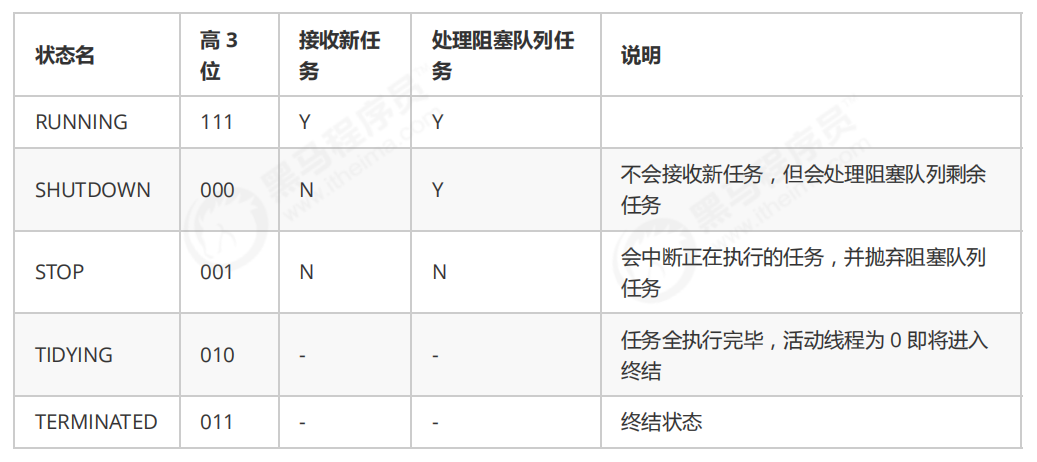
从数字上比较,TERMINATED > TIDYING > STOP > SHUTDOWN > RUNNING(因为是高三位,第一位是符号所以RUNNING是负数)
这些信息存储在一个原子变量 ctl 中,目的是将线程池状态与线程个数合二为一,这样就可以用一次 cas 原子操作进行赋值。
// c 为旧值, ctlOf 返回结果为新值ctl.compareAndSet(c, ctlOf(targetState, workerCountOf(c))));// rs 为高 3 位代表线程池状态, wc 为低 29 位代表线程个数,ctl 是合并它们private static int ctlOf(int rs, int wc) { return rs | wc; }
构造方法
public ThreadPoolExecutor(int corePoolSize,int maximumPoolSize,long keepAliveTime,TimeUnit unit,BlockingQueue<Runnable> workQueue,ThreadFactory threadFactory,RejectedExecutionHandler handler)
- corePoolSize 核心线程数目 (最多保留的线程数)
- maximumPoolSize 最大线程数目
- keepAliveTime 生存时间 - 针对救急线程
- unit 时间单位 - 针对救急线程
- workQueue 阻塞队列
- threadFactory 线程工厂 - 可以为线程创建时起个好名字
- handler 拒绝策略
工作方式:
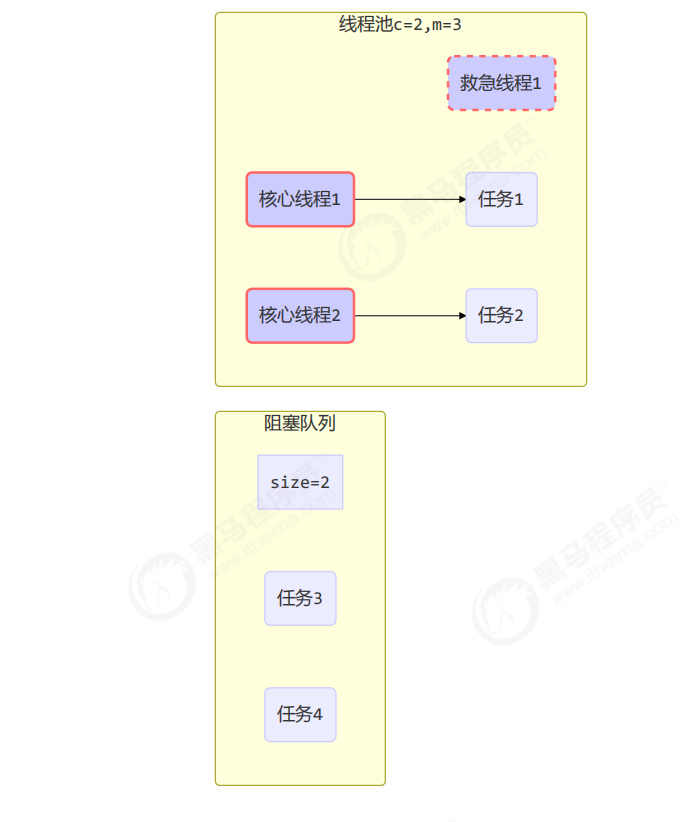
- 线程池中刚开始没有线程,当一个任务提交给线程池后,线程池会创建一个新线程来执行任务。
- 当线程数达到 corePoolSize 并没有线程空闲,这时再加入任务,新加的任务会被加入workQueue 队列排队,直到有空闲的线程。
- 如果队列选择了有界队列,那么任务超过了队列大小时,会创建 maximumPoolSize - corePoolSize 数目的线程来救急。
- 如果线程到达 maximumPoolSize 仍然有新任务这时会执行拒绝策略。拒绝策略 jdk 提供了 4 种实现,其它著名框架也提供了实现
- AbortPolicy 让调用者抛出 RejectedExecutionException 异常,这是默认策略
- CallerRunsPolicy 让调用者运行任务
- DiscardPolicy 放弃本次任务
- DiscardOldestPolicy 放弃队列中最早的任务,本任务取而代之
- Dubbo 的实现,在抛出 RejectedExecutionException 异常之前会记录日志,并 dump 线程栈信息,方
- 便定位问题
- Netty 的实现,是创建一个新线程来执行任务
- ActiveMQ 的实现,带超时等待(60s)尝试放入队列,类似我们之前自定义的拒绝策略
- PinPoint 的实现,它使用了一个拒绝策略链,会逐一尝试策略链中每种拒绝策略
- 当高峰过去后,超过corePoolSize 的救急线程如果一段时间没有任务做,需要结束节省资源,这个时间由keepAliveTime 和 unit 来控制。

根据这个构造方法,JDK Executors 类中提供了众多工厂方法来创建各种用途的线程池。
newFixedThreadPool
public static ExecutorService newFixedThreadPool(int nThreads) {return new ThreadPoolExecutor(nThreads, nThreads,0L, TimeUnit.MILLISECONDS,new LinkedBlockingQueue<Runnable>());}
特点
- 核心线程数是 0, 最大线程数是 Integer.MAX_VALUE,救急线程的空闲生存时间是 60s,意味着
- 全部都是救急线程(60s 后可以回收)
- 救急线程可以无限创建
- 队列采用了 SynchronousQueue 实现特点是,它没有容量,没有线程来取是放不进去的(一手交钱、一手交货)
SynchronousQueue<Integer> integers = new SynchronousQueue<>();new Thread(() -> {try {log.debug("putting {} ", 1);integers.put(1);log.debug("{} putted...", 1);log.debug("putting...{} ", 2);integers.put(2);log.debug("{} putted...", 2);} catch (InterruptedException e) {e.printStackTrace();}},"t1").start();sleep(1);new Thread(() -> {try {log.debug("taking {}", 1);integers.take();} catch (InterruptedException e) {e.printStackTrace();}},"t2").start();sleep(1);new Thread(() -> {try {log.debug("taking {}", 2);integers.take();} catch (InterruptedException e) {e.printStackTrace();}},"t3").start();
输出
11:48:15.500 c.TestSynchronousQueue [t1] - putting 111:48:16.500 c.TestSynchronousQueue [t2] - taking 111:48:16.500 c.TestSynchronousQueue [t1] - 1 putted...11:48:16.500 c.TestSynchronousQueue [t1] - putting...211:48:17.502 c.TestSynchronousQueue [t3] - taking 211:48:17.503 c.TestSynchronousQueue [t1] - 2 putted...
评价 整个线程池表现为线程数会根据任务量不断增长,没有上限,当任务执行完毕,空闲 1分钟后释放线程。 适合任务数比较密集,但每个任务执行时间较短的情况。
newSingleThreadExecutor
使用场景:
希望多个任务排队执行。线程数固定为 1,任务数多于 1 时,会放入无界队列排队。任务执行完毕,这唯一的线程
也不会被释放。
区别:
- 自己创建一个单线程串行执行任务,如果任务执行失败而终止那么没有任何补救措施,而线程池还会新建一个线程,保证池的正常工作
- Executors.newSingleThreadExecutor() 线程个数始终为1,不能修改
- FinalizableDelegatedExecutorService 应用的是装饰器模式,只对外暴露了 ExecutorService 接口,因此不能调用 ThreadPoolExecutor 中特有的方法
- Executors.newFixedThreadPool(1) 初始时为1,以后还可以修改
- 对外暴露的是 ThreadPoolExecutor 对象,可以强转后调用 setCorePoolSize 等方法进行修改
提交任务
// 执行任务void execute(Runnable command);// 提交任务 task,用返回值 Future 获得任务执行结果<T> Future<T> submit(Callable<T> task);// 提交 tasks 中所有任务<T> List<Future<T>> invokeAll(Collection<? extends Callable<T>> tasks)throws InterruptedException;// 提交 tasks 中所有任务,带超时时间<T> List<Future<T>> invokeAll(Collection<? extends Callable<T>> tasks,long timeout, TimeUnit unit)throws InterruptedException;// 提交 tasks 中所有任务,哪个任务先成功执行完毕,返回此任务执行结果,其它任务取消<T> T invokeAny(Collection<? extends Callable<T>> tasks)throws InterruptedException, ExecutionException;// 提交 tasks 中所有任务,哪个任务先成功执行完毕,返回此任务执行结果,其它任务取消,带超时时间<T> T invokeAny(Collection<? extends Callable<T>> tasks,long timeout, TimeUnit unit)throws InterruptedException, ExecutionException, TimeoutException;
关闭线程
shutdown
/*线程池状态变为 SHUTDOWN- 不会接收新任务- 但已提交任务会执行完- 此方法不会阻塞调用线程的执行*/void shutdown();
public void shutdown() {final ReentrantLock mainLock = this.mainLock;mainLock.lock();try {checkShutdownAccess();// 修改线程池状态advanceRunState(SHUTDOWN);// 仅会打断空闲线程interruptIdleWorkers();onShutdown(); // 扩展点 ScheduledThreadPoolExecutor} finally {mainLock.unlock();}// 尝试终结(没有运行的线程可以立刻终结,如果还有运行的线程也不会等)tryTerminate();}
shutdownNow
/*线程池状态变为 STOP- 不会接收新任务- 会将队列中的任务返回- 并用 interrupt 的方式中断正在执行的任务*/List<Runnable> shutdownNow();
public List<Runnable> shutdownNow() {List<Runnable> tasks;final ReentrantLock mainLock = this.mainLock;mainLock.lock();try {checkShutdownAccess();// 修改线程池状态advanceRunState(STOP);// 打断所有线程interruptWorkers();// 获取队列中剩余任务tasks = drainQueue();} finally {mainLock.unlock();}// 尝试终结tryTerminate();return tasks;}
其它方法
// 不在 RUNNING 状态的线程池,此方法就返回 trueboolean isShutdown();// 线程池状态是否是 TERMINATEDboolean isTerminated();// 调用 shutdown 后,由于调用线程并不会等待所有任务运行结束,因此如果它想在线程池 TERMINATED 后做些事情,可以利用此方法等待boolean awaitTermination(long timeout, TimeUnit unit) throws InterruptedException;
模式之 Worker Thread
任务调度线程池
在『任务调度线程池』功能加入之前,可以使用 java.util.Timer 来实现定时功能,Timer 的优点在于简单易用,但由于所有任务都是由同一个线程来调度,因此所有任务都是串行执行的,同一时间只能有一个任务在执行,前一个任务的延迟或异常都将会影响到之后的任务。
public static void main(String[] args) {Timer timer = new Timer();TimerTask task1 = new TimerTask() {@Overridepublic void run() {log.debug("task 1");sleep(2);}};TimerTask task2 = new TimerTask() {@Overridepublic void run() {log.debug("task 2");}};// 使用 timer 添加两个任务,希望它们都在 1s 后执行// 但由于 timer 内只有一个线程来顺序执行队列中的任务,因此『任务1』的延时,影响了『任务2』的执行timer.schedule(task1, 1000);timer.schedule(task2, 1000);}
输出
20:46:09.444 c.TestTimer [main] - start...20:46:10.447 c.TestTimer [Timer-0] - task 120:46:12.448 c.TestTimer [Timer-0] - task 2
使用 ScheduledExecutorService 改写:
ScheduledExecutorService executor = Executors.newScheduledThreadPool(2);// 添加两个任务,希望它们都在 1s 后执行executor.schedule(() -> {System.out.println("任务1,执行时间:" + new Date());try { Thread.sleep(2000); } catch (InterruptedException e) { }}, 1000, TimeUnit.MILLISECONDS);executor.schedule(() -> {System.out.println("任务2,执行时间:" + new Date());}, 1000, TimeUnit.MILLISECONDS);
输出
任务1,执行时间:Thu Jan 03 12:45:17 CST 2019任务2,执行时间:Thu Jan 03 12:45:17 CST 2019
scheduleAtFixedRate 例子:
ScheduledExecutorService pool = Executors.newScheduledThreadPool(1);log.debug("start...");pool.scheduleAtFixedRate(() -> {log.debug("running...");}, 1, 1, TimeUnit.SECONDS);
输出
21:45:43.167 c.TestTimer [main] - start...21:45:44.215 c.TestTimer [pool-1-thread-1] - running...21:45:45.215 c.TestTimer [pool-1-thread-1] - running...21:45:46.215 c.TestTimer [pool-1-thread-1] - running...21:45:47.215 c.TestTimer [pool-1-thread-1] - running...
scheduleAtFixedRate 例子(任务执行时间超过了间隔时间):
ScheduledExecutorService pool = Executors.newScheduledThreadPool(1);log.debug("start...");pool.scheduleAtFixedRate(() -> {log.debug("running...");sleep(2);}, 1, 1, TimeUnit.SECONDS);
输出分析:一开始,延时 1s,接下来,由于任务执行时间 > 间隔时间,间隔被『撑』到了 2s
21:44:30.311 c.TestTimer [main] - start...21:44:31.360 c.TestTimer [pool-1-thread-1] - running...21:44:33.361 c.TestTimer [pool-1-thread-1] - running...21:44:35.362 c.TestTimer [pool-1-thread-1] - running...21:44:37.362 c.TestTimer [pool-1-thread-1] - running
scheduleWithFixedDelay 例子:
ScheduledExecutorService pool = Executors.newScheduledThreadPool(1);log.debug("start...");pool.scheduleWithFixedDelay(()-> {log.debug("running...");sleep(2);}, 1, 1, TimeUnit.SECONDS);
输出分析:一开始,延时 1s,scheduleWithFixedDelay 的间隔是 上一个任务结束 <-> 延时 <-> 下一个任务开始 所以间隔都是 3s
21:40:55.078 c.TestTimer [main] - start...21:40:56.140 c.TestTimer [pool-1-thread-1] - running...21:40:59.143 c.TestTimer [pool-1-thread-1] - running...21:41:02.145 c.TestTimer [pool-1-thread-1] - running...21:41:05.147 c.TestTimer [pool-1-thread-1] - running...
评价 整个线程池表现为:线程数固定,任务数多于线程数时,会放入无界队列排队。任务执行完毕,这些线程也不会被释放。用来执行延迟或反复执行的任务。
正确处理执行任务异常
方法1:主动捉异常
pool.submit(() -> {try {log.debug("task1");int i = 1 / 0;} catch (Exception e) {log.error("error:", e);}});
输出
21:59:04.558 c.TestTimer [pool-1-thread-1] - task121:59:04.562 c.TestTimer [pool-1-thread-1] - error:java.lang.ArithmeticException: / by zeroat cn.itcast.n8.TestTimer.lambda$main$0(TestTimer.java:28)at java.util.concurrent.Executors$RunnableAdapter.call(Executors.java:511)at java.util.concurrent.FutureTask.run(FutureTask.java:266)at java.util.concurrent.ThreadPoolExecutor.runWorker(ThreadPoolExecutor.java:1149)at java.util.concurrent.ThreadPoolExecutor$Worker.run(ThreadPoolExecutor.java:624)at java.lang.Thread.run(Thread.java:748)
方法2:使用 Future
ExecutorService pool = Executors.newFixedThreadPool(1);ExecutorService pool = Executors.newFixedThreadPool(1);Future<Boolean> f = pool.submit(() -> {log.debug("task1");int i = 1 / 0;return true;});log.debug("result:{}", f.get());
输出
21:54:58.208 c.TestTimer [pool-1-thread-1] - task1Exception in thread "main" java.util.concurrent.ExecutionException:java.lang.ArithmeticException: / by zeroat java.util.concurrent.FutureTask.report(FutureTask.java:122)at java.util.concurrent.FutureTask.get(FutureTask.java:192)at cn.itcast.n8.TestTimer.main(TestTimer.java:31)Caused by: java.lang.ArithmeticException: / by zeroat cn.itcast.n8.TestTimer.lambda$main$0(TestTimer.java:28)at java.util.concurrent.FutureTask.run(FutureTask.java:266)at java.util.concurrent.ThreadPoolExecutor.runWorker(ThreadPoolExecutor.java:1149)at java.util.concurrent.ThreadPoolExecutor$Worker.run(ThreadPoolExecutor.java:624)at java.lang.Thread.run(Thread.java:748)
应用之定时任务
如何让每周四 18:00:00 定时执行任务?
public class TestSchedule {// 如何每周四18:00:00定时执行任务?public static void main(String[] args) {// 获取当前时间LocalDateTime now = LocalDateTime.now();// 获取周四时间LocalDateTime time = now.withHour(18).withMinute(0).withSecond(0).withNano(0).with(DayOfWeek.THURSDAY);// 如果当前时间大于本周周四,必须找到下周四if (now.compareTo(time) > 0) {time = time.plusWeeks(1);}// initailDelay 代表当前时间和周四的时间差// period 一周间隔的时间long initailDelay = Duration.between(now, time).toMillis();long period = 1000 * 60 * 60 * 24 * 7;ScheduledThreadPoolExecutor pool = new ScheduledThreadPoolExecutor(1);pool.scheduleAtFixedRate(() -> {System.out.println("running ... ");}, initailDelay, period, TimeUnit.SECONDS);}}
Tomcat线程池
Tomcat 在哪里用到了线程池呢
- LimitLatch 用来限流,可以控制最大连接个数,类似 J.U.C 中的 Semaphore 后面再讲
- Acceptor 只负责【接收新的 socket 连接】
- Poller 只负责监听 socket channel 是否有【可读的 I/O 事件】
- 一旦可读,封装一个任务对象(socketProcessor),提交给 Executor 线程池处理
- Executor 线程池中的工作线程最终负责【处理请求】
Tomcat 线程池扩展了 ThreadPoolExecutor,行为稍有不同
- 如果总线程数达到 maximumPoolSize
- 这时不会立刻抛 RejectedExecutionException 异常
- 而是再次尝试将任务放入队列,如果还失败,才抛出 RejectedExecutionException 异常
tomcat7的源码
submittedCount.incrementAndGet();try {super.execute(command);} catch (RejectedExecutionException rx) {if (super.getQueue() instanceof TaskQueue) {final TaskQueue queue = (TaskQueue)super.getQueue();try {if (!queue.force(command, timeout, unit)) {submittedCount.decrementAndGet();throw new RejectedExecutionException("Queue capacity is full.");}} catch (InterruptedException x) {submittedCount.decrementAndGet();Thread.interrupted();throw new RejectedExecutionException(x);}} else {submittedCount.decrementAndGet();throw rx;}}}
TaskQueue.java
public boolean force(Runnable o, long timeout, TimeUnit unit) throws InterruptedException {if ( parent.isShutdown() )throw new RejectedExecutionException("Executor not running, can't force a command into the queue");return super.offer(o,timeout,unit); //forces the item onto the queue, to be used if the taskis rejected}
Connector 配置

Executor 线程配置
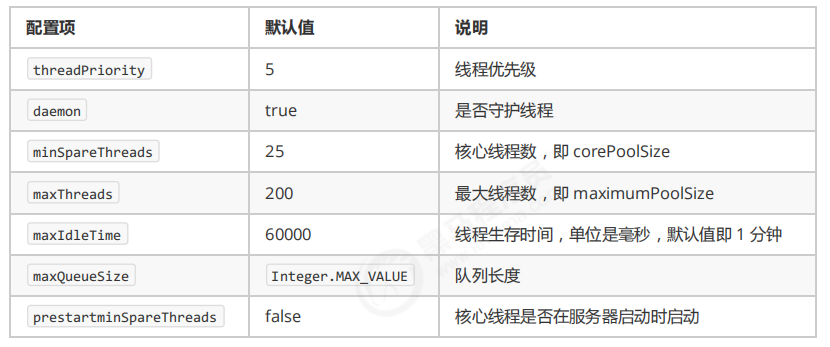

Fork/Join
概念
Fork/Join 是 JDK 1.7 加入的新的线程池实现,它体现的是一种分治思想,适用于能够进行任务拆分的 cpu 密集型运算
所谓的任务拆分,是将一个大任务拆分为算法上相同的小任务,直至不能拆分可以直接求解。跟递归相关的一些计算,如归并排序、斐波那契数列、都可以用分治思想进行求解
Fork/Join 在分治的基础上加入了多线程,可以把每个任务的分解和合并交给不同的线程来完成,进一步提升了运算效率
Fork/Join 默认会创建与 cpu 核心数大小相同的线程池
使用
提交给 Fork/Join 线程池的任务需要继承 RecursiveTask(有返回值)或 RecursiveAction(没有返回值),例如下面定义了一个对 1~n 之间的整数求和的任务。
class AddTask1 extends RecursiveTask<Integer> {int n;public AddTask1(int n) {this.n = n;}@Overridepublic String toString() {return "{" + n + '}';}@Overrideprotected Integer compute() {// 如果 n 已经为 1,可以求得结果了if (n == 1) {log.debug("join() {}", n);return n;}// 将任务进行拆分(fork)AddTask1 t1 = new AddTask1(n - 1);t1.fork();log.debug("fork() {} + {}", n, t1);// 合并(join)结果int result = n + t1.join();log.debug("join() {} + {} = {}", n, t1, result);return result;}}
然后提交给 ForkJoinPool 来执行
public static void main(String[] args) {ForkJoinPool pool = new ForkJoinPool(4);System.out.println(pool.invoke(new AddTask3(1, 10)));}
结果
[ForkJoinPool-1-worker-0] - fork() 2 + {1}[ForkJoinPool-1-worker-1] - fork() 5 + {4}[ForkJoinPool-1-worker-0] - join() 1[ForkJoinPool-1-worker-0] - join() 2 + {1} = 3[ForkJoinPool-1-worker-2] - fork() 4 + {3}[ForkJoinPool-1-worker-3] - fork() 3 + {2}[ForkJoinPool-1-worker-3] - join() 3 + {2} = 6[ForkJoinPool-1-worker-2] - join() 4 + {3} = 10[ForkJoinPool-1-worker-1] - join() 5 + {4} = 1515
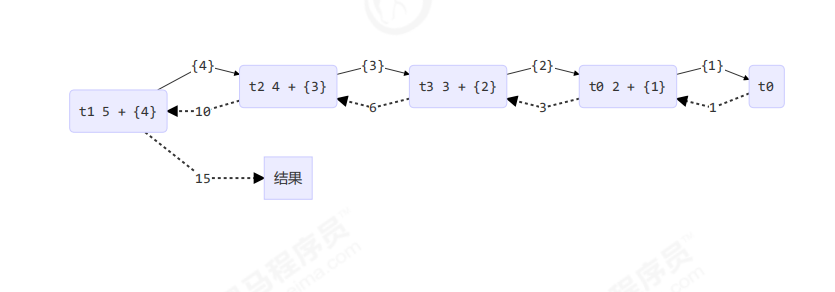
改进
class AddTask3 extends RecursiveTask<Integer> {int begin;int end;public AddTask3(int begin, int end) {this.begin = begin;this.end = end;}@Overridepublic String toString() {return "{" + begin + "," + end + '}';}@Overrideprotected Integer compute() {// 5, 5if (begin == end) {log.debug("join() {}", begin);return begin;}// 4, 5if (end - begin == 1) {log.debug("join() {} + {} = {}", begin, end, end + begin);return end + begin;}// 1 5int mid = (end + begin) / 2; // 3AddTask3 t1 = new AddTask3(begin, mid); // 1,3t1.fork();AddTask3 t2 = new AddTask3(mid + 1, end); // 4,5t2.fork();log.debug("fork() {} + {} = ?", t1, t2);int result = t1.join() + t2.join();log.debug("join() {} + {} = {}", t1, t2, result);return result;}}
结果
[ForkJoinPool-1-worker-0] - join() 1 + 2 = 3[ForkJoinPool-1-worker-3] - join() 4 + 5 = 9[ForkJoinPool-1-worker-0] - join() 3[ForkJoinPool-1-worker-1] - fork() {1,3} + {4,5} = ?[ForkJoinPool-1-worker-2] - fork() {1,2} + {3,3} = ?[ForkJoinPool-1-worker-2] - join() {1,2} + {3,3} = 6[ForkJoinPool-1-worker-1] - join() {1,3} + {4,5} = 1515


